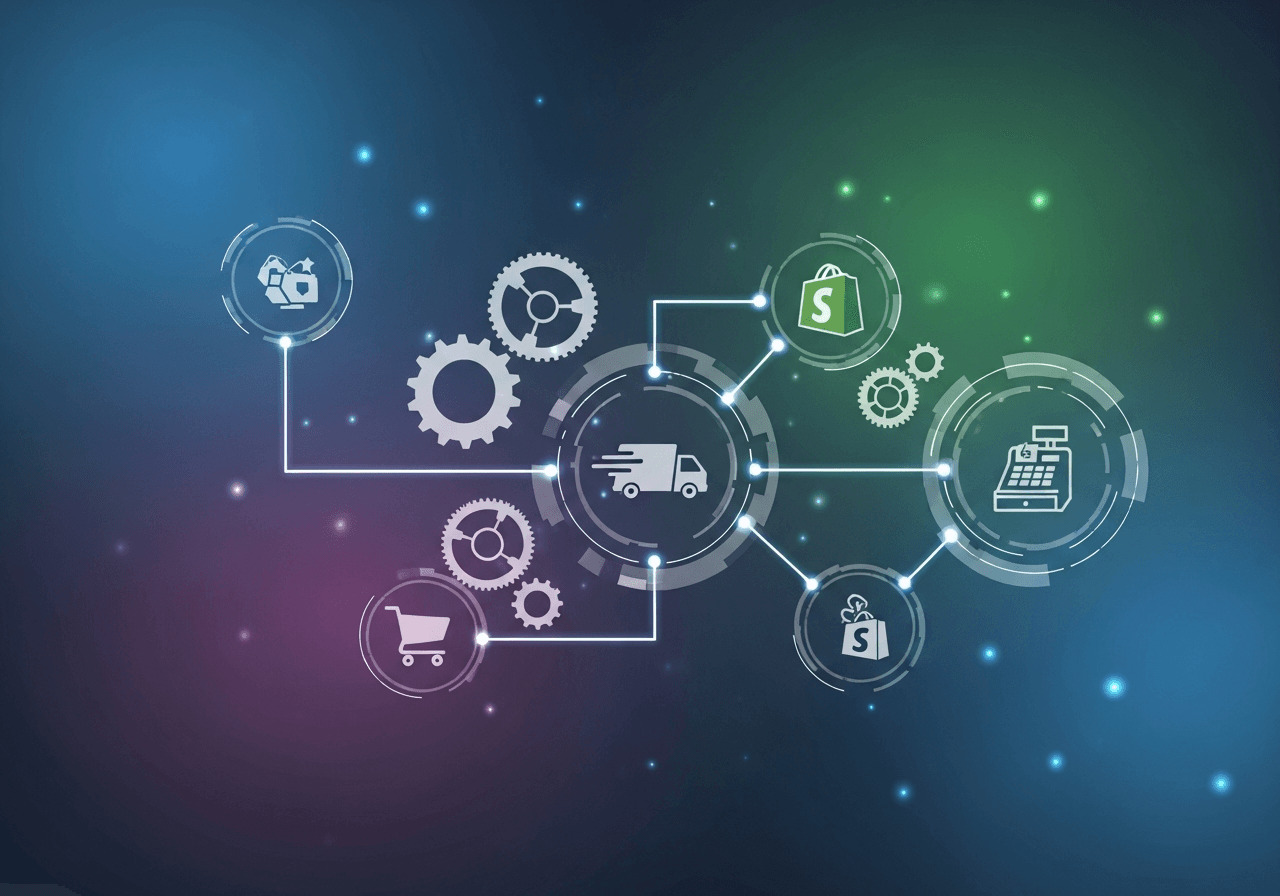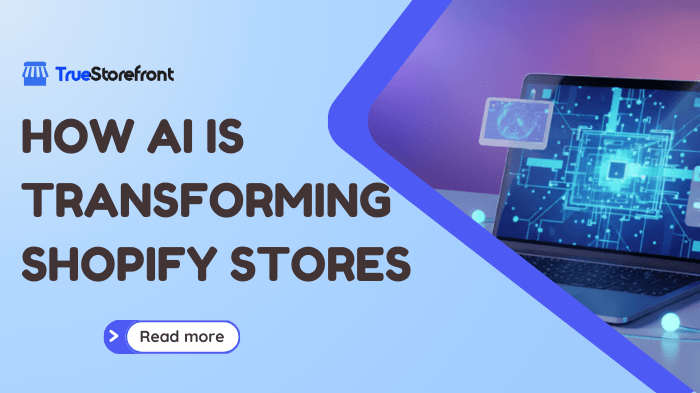In 2026, AI (artificial intelligence) is no longer a futuristic add‑on for Shopify merchants; it’s a core part of running a competitive, efficient, and highly personalized online store. As shopify ai and shopify automation mature, merchants are seeing meaningful gains in productivity, customer experience, and operational scaling. In this article, we will explore the top trends, use cases, and concrete examples of how AI is transforming Shopify stores and why you should consider adopting AI tools now.
I. How AI Is Transforming Shopify Stores?
1. The Rise of Built-In AI: Shopify Magic & Sidekick

One of the biggest shifts has come from Shopify itself. Native AI tools, like Shopify Magic, are deeply integrated into the admin. Magic helps generate product descriptions, email copy, landing page text, and SEO‑friendly content; all based on short prompts or basic product data.
Alongside Magic, Shopify Sidekick acts as an AI business assistant: you can ask it about trends, run simple admin tasks, or even request ideas for discounts, marketing campaigns, or product bundles.
This integration makes AI accessible, even for merchants who don’t want to juggle multiple third-party tools.
2. Predictive Analytics & Smarter Inventory
AI-driven predictive analytics is now a foundational piece of Shopify operations. These systems analyze historical sales data, seasonality, customer behavior, and external market signals to forecast demand more accurately. With this insight, merchants can reduce overstock, avoid stockouts, and optimize cash flow.
By combining these forecasts with automation workflows, stores can automatically trigger restocking alerts, reorder with suppliers, or reroute inventory freeing up manual effort and reducing human error.
3. Personalized Shopping Experiences & AI‑Driven Commerce
Personalization has become table stakes in 2026. AI models now analyze each visitor’s behavior clicks, time on page, past purchases and tailor the shopping journey dynamically:
-
AI-powered product recommendations: Based on individual customer profiles, AI suggests complementary items, upsells, or cross‑sells.
-
Intelligent search: With Shopify’s acquisition of Vantage Discovery, search functionality is now powered by generative AI and large language models (LLMs), offering more relevant, context-aware search results.
-
Virtual try-on & visualization: Multimodal AI (handling images, text, and even video) enables virtual try-on experiences. For example, customers can upload a photo or use AR-like previews to see how products look on them increasing confidence and reducing returns.
These experiences help create a highly customized, frictionless shopping flow.
4. Conversational Commerce & AI Agents
Chatbots and AI-powered assistants are no longer supplemental; they’re central to how stores interact with customers. Conversational AI handles everything from FAQs to order tracking to recommending products.
Voice commerce is also gaining ground. By 2026, voice-activated shopping assistants may become a common feature, allowing customers to browse, search, and even buy using verbal commands.
Further, AI agents are starting to manage post-purchase flows: they send follow-up messages, recovery emails, and personalized support all automated.
5. Automated Marketing & Ad Optimization

Marketing is another area where AI + automation is proving transformative for Shopify stores:
-
Ad campaign automation: AI tools create, optimize, and scale ad campaigns in real time. They adjust budgets, creative messaging, and targeting based on performance data.
-
AI generated content: Shopify Magic (or third-party copywriting tools) writes SEO-ready product descriptions, blog posts, and email copy, reducing the manual copy burden.
-
Email personalization: Using predictive behavior modeling, AI tailors email subject lines, send times, and content to maximize engagement and revenue.
These capabilities not only streamline marketing but also improve ROI by making campaigns more responsive and customer-specific.
6. Fraud Detection & Security
As AI adoption grows, so does risk but AI is helping here, too. Machine‑learning models analyze orders in real time to flag suspicious behavior or high-risk transactions.
By integrating with automated workflows (like Shopify Flow), stores can automatically cancel or review flagged orders before fulfillment, reducing chargebacks and fraud losses.
7. Operational Efficiency & AI‑Driven Back Office
Beyond customer-facing use cases, AI is transforming backend operations:
-
Automated reports & insights: AI can analyze sales, returns, inventory, customer segments; then generate digestible insight reports, highlighting trends and recommending actions.
-
Agentic workflows: Using tools like Shopify Flow in conjunction with intelligence engines, merchants can build agent-like automations: for example, when a product’s demand surge is detected, automatically increase ad spend, reorder, and send a promotion to relevant customers.
This means less manual overhead, fewer silos, and more strategic time for business owners.
8. Ethical & Trust‑Centered AI
With great power comes responsibility. The rise of AI in e-commerce has raised concerns around privacy, transparency, and fairness.
In 2026, forward-thinking Shopify merchants are adopting ethical AI practices; being transparent in how they use customer data, auditing algorithms for bias, and giving users control over AI-powered personalization. This fosters trust, which is critical for long-term customer loyalty.
9. Emerging Trend: Agentic Commerce
One of the most disruptive developments is agentic commerce. Thanks to integrations like ChatGPT’s “Instant Checkout,” customers may shop directly in conversational AI environments without ever landing on a store’s site.
In this paradigm, AI agents surface and transact your products on behalf of users — dramatically changing how discovery works and potentially reducing reliance on traditional search / ad channels.
10. Real-World Impact & Business Outcomes
Here’s what early adopters are seeing:
-
Higher conversion rates and AOV: Personalized recommendations and dynamic content are helping to increase order value.
-
Time savings: Automating customer service, order workflows, and content creation frees up tens of hours per week.
-
Cost reductions: Predictive inventory leads to less wasted capital, and AI-driven fraud detection cuts chargeback costs.
-
Better engagement: Conversational commerce and AI-powered email sequences deepen customer relationships and retention.
II. Why You Should Adopt AI Tools Now

-
Competitive Advantage: If you’re not using AI, you risk falling behind merchants who are using predictive analytics, smart search, and automation.
-
Scalability: AI scales with your business. As order volume grows, AI workflows handle repeatable tasks without linear increases in headcount.
-
Efficiency & Focus: Automation means you spend less time on manual or administrative tasks and more on strategy, design, and growth.
-
Personalization at Scale: AI helps you deliver one-to-one experiences even at high volume; that’s a game-changer for customer loyalty.
-
Risk Management: With AI-powered fraud detection and better demand forecasting, you can more safely scale operations.
III. Risks & Challenges to Consider
-
Data quality: AI is only as good as the data it learns from. Poor product data or inconsistent customer data can reduce model accuracy.
-
Ethics & privacy: You must balance personalization with transparency, and ensure your AI use respects customer privacy.
-
Over-automation risk: If you automate everything, you may lose the human touch. It’s important to identify workflows that need human oversight.
-
Cost & integration: While many AI tools are powerful, integrating and maintaining them requires investment. Start with high-impact use cases.
-
Over-automation risk: If you automate everything, you may lose the human touch. It’s important to identify workflows that need human oversight.
IV. Actionable Steps: How to Start Adopting AI in Your Shopify Store
-
Audit pain points: Identify which processes (content, support, inventory, marketing) are the most manual / time-consuming.
-
Pilot with a tool: Try a native AI feature (like Shopify Magic) or a trusted third-party AI app (e.g., predictive inventory, chatbot).
-
Measure impact: Track metrics such as conversion lift, time saved, average order value, and customer satisfaction.
-
Refine & scale: Based on the pilot, optimize workflows. As confidence builds, expand your AI adoption to other areas.
-
Establish ethics guardrails: Define how you will collect and use customer data. Be transparent in your store communications.
-
Monitor continuously: Periodically review AI performance, retrain models (if needed), and adjust workflows.
Conclusion
AI and automation are transforming Shopify stores in profound ways in 2026. From content generation and personalized shopping to predictive inventory and conversational commerce, the possibilities are wide and growing. By adopting AI tools, you can streamline operations, deliver more value to customers, and position your store for scalable growth. The future is not just automated it’s intelligent.
Read more:
